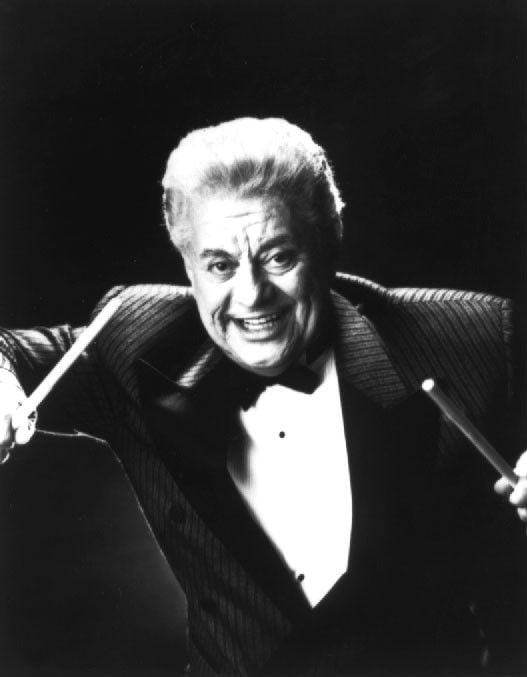
Some of Tito Puente's most popular songs include Oye Cu00f3mo Va, El Cayuco, Ran Kan Kan. These tracks have impressed fans and helped cement their place in the music industry.
Afro-cuban Percussion

Upcoming Tito Puente Tour

By virtue of his warm and buoyant stage manner, constant touring, longevity, and appearances in the mass media, Tito Puente became one of the most beloved symbols of Latin jazz. But more than that, he managed to keep his music remarkably fresh over the decades; as a timbales virtuoso, he combined mastery over every rhythmic nuance with old-fashioned showmanship. A trained musician, he was also a fine, lyrical vibraphonist, a gifted arranger, and played piano, congas, bongos, and saxophone. His appeal cut across all ages and ethnic groups, helped no doubt by Santana's best-selling cover versions of "Oye Como Va" and "Para Los Rumberos" in 1970 and 1971, and cameo appearances on The Cosby Show in the 1980s and the film The Mambo Kings in 1992. His brand of classic salsa is generally free of dark undercurrents, radiating a joyous, compulsively danceable party atmosphere. Rooted in Spanish Harlem, of Puerto Rican descent, Puente originally intended to become a dancer, but those ambitions were scotched by a torn ankle tendon suffered in an accident. At age 13, he began working in Ramon Olivero's big band as a drummer, and later he studied composing, orchestration, and piano at Juilliard. More importantly, he played with and absorbed the influence of Machito, who was successfully fusing Latin rhythms with progressive jazz. Forming the nine-piece Piccadilly Boys in 1947 and then expanding it to a full orchestra two years later, Puente recorded for Seeco, Tico, and eventually RCA Victor, helping to fuel the mambo craze that gave him the unofficial -- and ultimately lifelong -- title "King of the Mambo," or just "El Rey." Puente also helped popularize the cha-cha during the 1950s, and he was the only non-Cuban who was invited to a government-sponsored "50 Years of Cuban Music" celebration in Cuba in 1952. Among the major-league congueros who played with the Puente band in the '50s were Mongo Santamaria, Willie Bobo, Johnny Pacheco, and Ray Barretto, which resulted in some explosive percussion shootouts. Not one to paint himself into a tight Latin music corner, Puente's range extended to big-band jazz (Puente Goes Jazz), and in the '60s, bossa nova tunes, Broadway hits, boogaloos, and pop music, although in later years he tended to stick with older Latin jazz styles that became popularly known as salsa. In 1982, he started reeling off a string of several Latin jazz albums with octets or big bands for Concord Picante that gave him greater exposure and respect in the jazz world than he ever had. An indefatigable visitor to the recording studios, Puente recorded his 100th album, The Mambo King, in 1991 amid much ceremony and affection (an all-star Latin music concert at Los Angeles' Universal Amphitheatre in March 1992 commemorated the milestone), and he kept adding more titles to the tally throughout the '90s. He also appeared as a guest on innumerable albums over the years, and such jazz stars as Phil Woods, George Shearing, James Moody, Dave Valentin, and Terry Gibbs played on Puente's own later albums. Just months after accepting his fifth Grammy award, he died on June 1, 2000. Several months later, Puente was recognized at the first annual Latin Grammy Awards, winning for Best Traditional Tropical Perfomance for Mambo Birdland. ~ Richard S. Ginell, Rovi
Read moreBy virtue of his warm and buoyant stage manner, constant touring, longevity, and appearances in the mass media, Tito Puente became one of the most beloved symbols of Latin jazz. But more than that, he managed to keep his music remarkably fresh over the decades; as a timbales virtuoso, he combined mastery over every rhythmic nuance with old-fashioned showmanship. A trained musician, he was also a fine, lyrical vibraphonist, a gifted arranger, and played piano, congas, bongos, and saxophone. His appeal cut across all ages and ethnic groups, helped no doubt by Santana's best-selling cover versions of "Oye Como Va" and "Para Los Rumberos" in 1970 and 1971, and cameo appearances on The Cosby Show in the 1980s and the film The Mambo Kings in 1992. His brand of classic salsa is generally free of dark undercurrents, radiating a joyous, compulsively danceable party atmosphere. Rooted in Spanish Harlem, of Puerto Rican descent, Puente originally intended to become a dancer, but those ambitions were scotched by a torn ankle tendon suffered in an accident. At age 13, he began working in Ramon Olivero's big band as a drummer, and later he studied composing, orchestration, and piano at Juilliard. More importantly, he played with and absorbed the influence of Machito, who was successfully fusing Latin rhythms with progressive jazz. Forming the nine-piece Piccadilly Boys in 1947 and then expanding it to a full orchestra two years later, Puente recorded for Seeco, Tico, and eventually RCA Victor, helping to fuel the mambo craze that gave him the unofficial -- and ultimately lifelong -- title "King of the Mambo," or just "El Rey." Puente also helped popularize the cha-cha during the 1950s, and he was the only non-Cuban who was invited to a government-sponsored "50 Years of Cuban Music" celebration in Cuba in 1952. Among the major-league congueros who played with the Puente band in the '50s were Mongo Santamaria, Willie Bobo, Johnny Pacheco, and Ray Barretto, which resulted in some explosive percussion shootouts. Not one to paint himself into a tight Latin music corner, Puente's range extended to big-band jazz (Puente Goes Jazz), and in the '60s, bossa nova tunes, Broadway hits, boogaloos, and pop music, although in later years he tended to stick with older Latin jazz styles that became popularly known as salsa. In 1982, he started reeling off a string of several Latin jazz albums with octets or big bands for Concord Picante that gave him greater exposure and respect in the jazz world than he ever had. An indefatigable visitor to the recording studios, Puente recorded his 100th album, The Mambo King, in 1991 amid much ceremony and affection (an all-star Latin music concert at Los Angeles' Universal Amphitheatre in March 1992 commemorated the milestone), and he kept adding more titles to the tally throughout the '90s. He also appeared as a guest on innumerable albums over the years, and such jazz stars as Phil Woods, George Shearing, James Moody, Dave Valentin, and Terry Gibbs played on Puente's own later albums. Just months after accepting his fifth Grammy award, he died on June 1, 2000. Several months later, Puente was recognized at the first annual Latin Grammy Awards, winning for Best Traditional Tropical Perfomance for Mambo Birdland. ~ Richard S. Ginell, Rovi

Some of Tito Puente's most popular songs include Oye Cu00f3mo Va, El Cayuco, Ran Kan Kan. These tracks have impressed fans and helped cement their place in the music industry.

You can listen to Tito Puente's music on all major streaming platforms, including Spotify, Apple Music, and YouTube. Their most popular songs include Oye Cu00f3mo Va, El Cayuco, Ran Kan Kan, and more.

Tito Puente is known for their distinctive sound in the afro-cuban percussion genre, often blending elements of jazz puertorriqueno, making them a unique voice in the music world.

You can find the ticket details about Tito Puente concert from AllEvents.